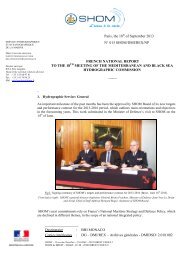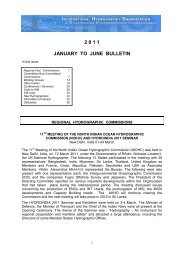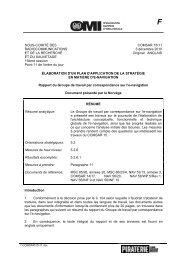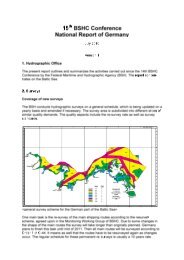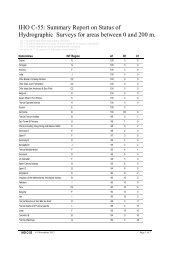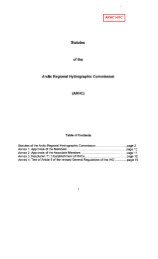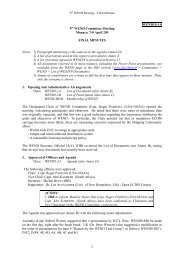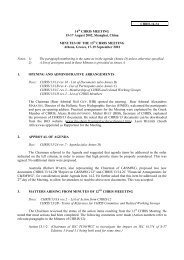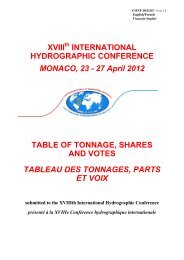Report - IHO
Report - IHO
Report - IHO
You also want an ePaper? Increase the reach of your titles
YUMPU automatically turns print PDFs into web optimized ePapers that Google loves.
4<br />
<br />
<br />
Creation of a survey capability. This phase requires the State’s commitment to sustain<br />
capability and funding for personnel and equipment or contract surveys. <strong>IHO</strong> CBSC<br />
can assist in training/technology transfer.<br />
Production of charts and publications. Independent national capability at this level<br />
requires high levels of investment and continuous support in the long term.<br />
In order to conduct hydrographic activities, each country shall determine what infrastructure<br />
already exists for Maritime Safety Information, hydrographic survey and provision of<br />
navigational charts. This can be achieved through assessment visits, technical workshops and<br />
seminars, various projects (including co-operation with other International Organizations).<br />
Examples of bilateral assistance to improve hydrographic capabilities were given.<br />
IMO Objectives and its role in the safety of navigation (Gurpreet S. Singhota, IMO)<br />
The IMO and <strong>IHO</strong> co-operation was outlined. <strong>IHO</strong>’s involvement to promote safety of<br />
navigation and protection of the marine environment through Capacity Building, the<br />
development of international standards for hydrography, inputs to IMO’s technical bodies…<br />
was highlighted. Inversely, IMO whose mandate is related to safety of navigation and<br />
protection of environment can promote hydrography but cannot take decisions instead of<br />
governments. SOLAS Chapter V Resolutions were developed. Current status of long-range<br />
identification and tracking of ships (LRIT) implementation was given.<br />
In order to answer the question raised by the President of the IHB Directing Committee “Why<br />
IMO Members are not <strong>IHO</strong> Member States and how to improve <strong>IHO</strong> membership in Africa?”<br />
a discussion closed the first theme.<br />
The complexity to apply for <strong>IHO</strong> membership was stressed.<br />
Following a question of the representative of Mozambique, the feasibility to include <strong>IHO</strong> in<br />
the UN structure was discussed (because IMO which depends on UN and <strong>IHO</strong> are closely<br />
linked). It was recalled that this issue had been addressed by the <strong>IHO</strong> Strategic Plan Working<br />
Group (SPWG) which identified three options: statu quo, join the UN structure as a<br />
specialized body and join the IMO. After analysis, it seemed not appropriate for <strong>IHO</strong> to join<br />
the UN system with the risk to get embroiled in political issues. It was agreed that the <strong>IHO</strong><br />
should remain an independent intergovernmental organization of its own right. This decision<br />
does not affect the close link between IMO and <strong>IHO</strong>.<br />
The main obstacle to join <strong>IHO</strong> remains the lack of resources (manpower and equipment).<br />
Malawi stressed the difficulty to access training. It was recalled that training facilities is not<br />
restricted to military structures. In Seychelles, the hydrographic tasks which requires a lot of<br />
resources is considered as a load. In consequence, it is not identified as a priority for the<br />
government. In numerous Coastal States of the SAIHC region, it is difficult to identify the<br />
proper hydrographers to be trained, to find them a job at the end of the training period and to<br />
keep them in the national hydrographic structure. The problem of sustainability was raised.<br />
Afternoon session<br />
The basic activities of hydrographic offices: the <strong>IHO</strong> M-2 publication related to National<br />
Maritime Policies and Hydrographic Services.<br />
The importance of accurate nautical information (Paul Canham, UK)<br />
Phase I of the Capacity Building: collection and circulation of information to maintain<br />
existing charts and publications<br />
4



